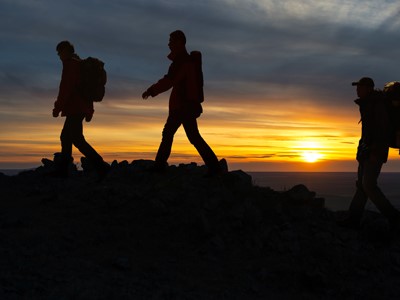October 2021 - It's getting dark
by Nigel Williams

Preparation is key before it gets dark. Walking poles are helpful across difficult ground at night, but they can be a distraction from using the tools of navigation which need full concentration. With reduced vision other senses can kick in. Contours, feeling the ground and listening for running water can be key to navigation.
Prior to darkness, stop, have a snack break and make sure navigation tools are easily accessible. Moving at night can be slow and the temperature may drop. Keep hats, gloves etc. handy and put the head torch on your head (switched off). If need be, call friends to let them know you are running late. There is often a better signal on the tops. Set the first or a key bearing on your compass. If using the phone gps function to back up map and compass, turn to airplane mode to extend battery life and try to use it just for checking your position.

Try to keep the torch off for as long as possible. Night vision will develop as it gets dark. Head torch beams tend to focus our vision. Turning off all lights, wait a few minutes for night vision to develop then squat down to silhouette the landscape around for an improved view of the terrain.
Lastly, to help keep an element of night vision, close one eye when there is a group discussion around the map and headtorches are dazzling.
Night navigation is not difficult but does need concentration and a bit of confidence.
Return to the Navigation Blog
 FREE UK delivery
FREE UK delivery For Christmas delivery information
For Christmas delivery information 







